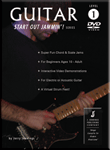
In teaching people strum patterns, the main obstacle I run across is to get out of what I call the “shopping list” mode. I’ll come back to that idea in a second. A lot of beginner books will show “down” and “up” strums for the basic patterns, but somehow manage not to communicate the rhythmic breakdown.
In order to play probably 90 percent of all rhythm patterns, what is needed is a steady down-up motion of the strumming arm. My first step in getting you to understand any pattern is, start by muting all the strings with the left hand. (Lay your fingers across the strings with no pressure.) This gives you a not-so-noisy way to just get the initial motion started. Begin to strum down and up on the strings (in that order). Once you get that started, you can begin to count, “One and two and three and four and”, steadily with the strums. Make sure the beats (one, two, three, four) are all down strums, and the “upbeats” (and, and, and, and,) are all up strums. You will want to actually just practice this step for a while before moving on. You want it to be second nature.
How many times are we flying past the strings in each measure? If you count all the beats and upbeats, that would be eight passes by the strings, right? (It won’t always be eight if we are working with other time signatures or if we are doing 16th notes, which would double it. But let’s keep it simple.) So we have eight even chunks of time. I refer to this as the “grid”, because it provides the background for whatever strum pattern you’re doing.
Think of a picture with low resolution, like in a newspaper. Think black and white. It’s made of a very predictably spaced dots that will either be black or white. Black dots would be the equivalent of passes by the string in which you hit the string. White dots would be the times you miss the string. But the steady movement of the hand never varies. If you were ever to stop your strumming arm and think “let’s see… I just did an up stroke and now it says down…” then you’ve just entered into the “shopping list” mode of thinking. The down and up arm movements HAVE to stay steady.
Try it on a G chord. Decide beforehand which of the eight passes by the strings will actually make contact, and which ones won’t. Here’s a sample:
1 + 2 + 3 + 4 +
Notice I underlined the one, the “and of two”, and the four. Those will be the strums that make contact. The others will be misses. In case I didn’t mention it enough, the steadiness of the down and up motions is everything.
In my beginner book, “Guitar One – Start Out Jammin”, I get into a lot more rhythmic patterns. And they are all on the DVD as well, in song examples.
Jennings PublishingMusic in a Nutshell - Beginner | Intermediate | Pro
Beginner Guitar Package - 32 Week Curriculum
Triad Magic - An Introduction to Guitar Chord Theory
Guitar 1 Start Out Jammin' - Beginner Guitar Book & DVD
Classic Rock Rudiments for Lead Guitar Book & DVD
Guitarist's Link to Sight Reading - #1 Guide to Understanding Studio Charts
Bassist's Link to Sight Reading - #1 Guide to Understanding Studio Charts
Drummer's Link to Sight Reading - #1 Guide to Understanding Studio Charts
